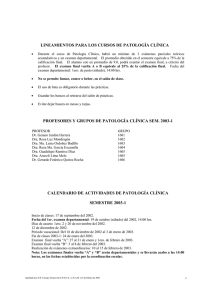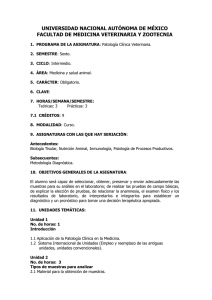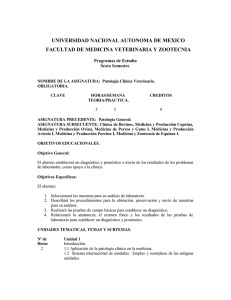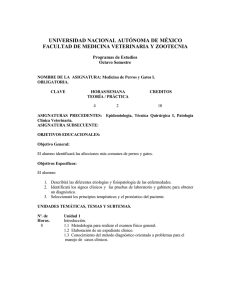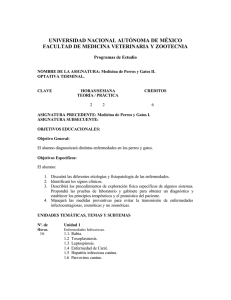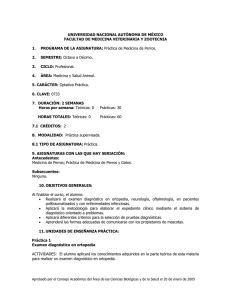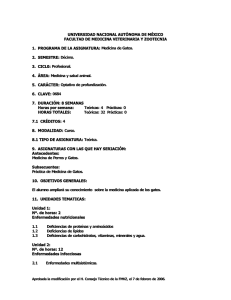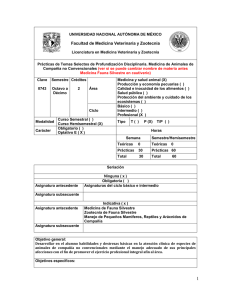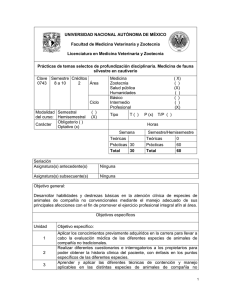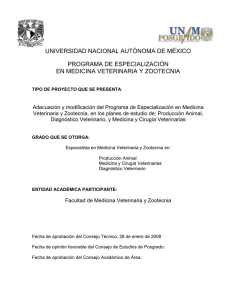PRACTICA_DE_PROFUNDIZACION_EN_PATOLOGIA_CLINICA.pdf
Anuncio
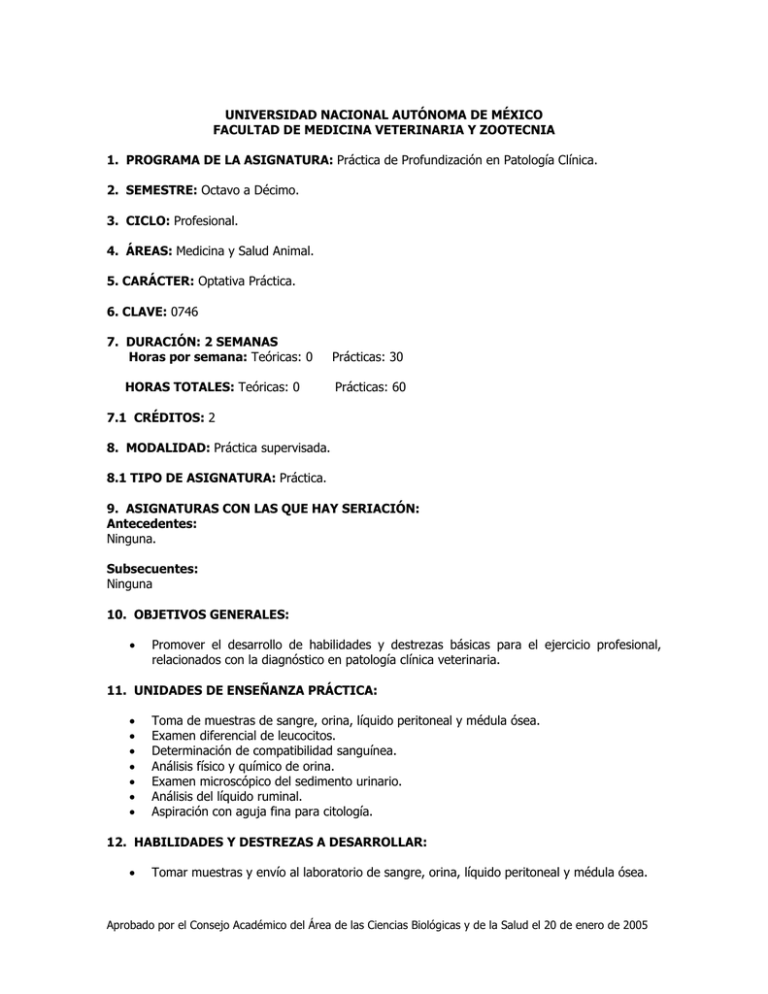
UNIVERSIDAD NACIONAL AUTÓNOMA DE MÉXICO FACULTAD DE MEDICINA VETERINARIA Y ZOOTECNIA 1. PROGRAMA DE LA ASIGNATURA: Práctica de Profundización en Patología Clínica. 2. SEMESTRE: Octavo a Décimo. 3. CICLO: Profesional. 4. ÁREAS: Medicina y Salud Animal. 5. CARÁCTER: Optativa Práctica. 6. CLAVE: 0746 7. DURACIÓN: 2 SEMANAS Horas por semana: Teóricas: 0 Prácticas: 30 HORAS TOTALES: Teóricas: 0 Prácticas: 60 7.1 CRÉDITOS: 2 8. MODALIDAD: Práctica supervisada. 8.1 TIPO DE ASIGNATURA: Práctica. 9. ASIGNATURAS CON LAS QUE HAY SERIACIÓN: Antecedentes: Ninguna. Subsecuentes: Ninguna 10. OBJETIVOS GENERALES: • Promover el desarrollo de habilidades y destrezas básicas para el ejercicio profesional, relacionados con la diagnóstico en patología clínica veterinaria. 11. UNIDADES DE ENSEÑANZA PRÁCTICA: • • • • • • • Toma de muestras de sangre, orina, líquido peritoneal y médula ósea. Examen diferencial de leucocitos. Determinación de compatibilidad sanguínea. Análisis físico y químico de orina. Examen microscópico del sedimento urinario. Análisis del líquido ruminal. Aspiración con aguja fina para citología. 12. HABILIDADES Y DESTREZAS A DESARROLLAR: • Tomar muestras y envío al laboratorio de sangre, orina, líquido peritoneal y médula ósea. Aprobado por el Consejo Académico del Área de las Ciencias Biológicas y de la Salud el 20 de enero de 2005 • • • • • • Realizar Realizar Realizar Realizar Realizar Realizar conteo de leucocitos y eritrocitos y su interpretación clínica. conteo diferencial de leucocitos y su interpretación clínica. pruebas de compatibilidad sanguínea. el análisis físico y químico del sedimento urinario y su interpretación clínica. el análisis del líquido ruminal y su interpretación clínica. la aspiración con aguja fina para estudios citológicos. 13. BIBLIOGRAFÍA BÁSICA: 1. 2. 3. 4. 5. 6. 7. 8. Bush BM. Interpretation of Laboratory Results for Small Animal Clinicians. Blackwell Scientific, Philadelphia. 2000. Dibartola SP. Fluid Therapy in Small Animal Practice. WB Saunders. Philadelphia, 2002. Duncan JR et al. Veterinary Laboratory Medicine. Clinical pathology. Iowa State University Press, Ames. 2003. Feldman BV et al. Schalm’s Veterinary Hematology. 5th ed. Lippincott, Williams and Wilkins. Philadelphia. 2000. Harvey JW. Atlas of Veterinary Hematology. WB Saunders. Philadelphia, 2001. Jain NC. Essentials of Veterinary Hematology. Lea & Febiger. Philadelphia, 2000. Kerry MG. Veterinary Laboratory Medicine. 2nd ed. Blackwell Science. Boston. 2002. Meyer DJ, Harvey JW. Veterinary Laboratory Medicine. Interpretation & Diagnosis. 2nd ed. WB Saunders, Philadelphia, 2001. 14. BIBLIOGRAFÍA COMPLEMENTARIA: 1. Campbell TW. Avian Hematology and Cytology. Iowa. State University Press, Ames. 2001. 2. Cowell RL & Tyler RD. Cytology and Hematology of the Horse. American Vet. Pub. California, 2000. 3. Ettinger SJ. Textbook of Veterinary Internal Medicine. Diseases of the dog and cat. 4th ed. WB Saunders. Philadelphia, 1995. 4. Feldman EC, Nelson RW. Canine and Feline Endocrinology and Reproduction. 2nd ed. WB Saunders. Philadelphia, 2003. 5. Osborne CA, Finco DR. Canine and Feline Neurology and Urology . William & Wilkins. Philadelphia, 2000. 6. Radostits OM, Blood DC, Gay CC. Veterinary Medicine. 8th ed. Balliere Tindall. London. 1997. 7. Smith BP. Large Animal Internal Medicine. Diseases of horses, cattle, sheep and goats. C.V. Mosby. St. Louis Missouri, 2001. 8. Willard MD et al. Small Animal Clinical Diagnosis by Laboratory Methods. 3rd ed. WB Saunders. Philadelphia, 1999. 15. METODOLOGÍAS DE ENSEÑANZA Y DE APRENDIZAJE: • • • • Demostraciones prácticas. Solución de problemas prácticos. Elaboración y presentación de casos. Participación en seminarios. 16. SUGERENCIAS PARA LA EVALUACIÓN DE LA ASIGNATURA: • • Exámenes escritos. Presentación de informes de casos. Aprobado por el Consejo Académico del Área de las Ciencias Biológicas y de la Salud el 20 de enero de 2005 • • Participación en seminarios. Exámenes prácticos. 17. PERFIL PROFESIOGRÁFICO DE QUIENES PUEDEN IMPARTIR LA ASIGNATURA: Médicos Veterinarios Zootecnistas con experiencia en el área mínima de 5 años, Especialistas en patología clínica. Aprobado por el Consejo Académico del Área de las Ciencias Biológicas y de la Salud el 20 de enero de 2005
